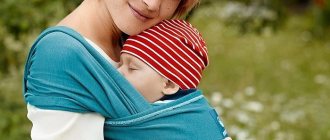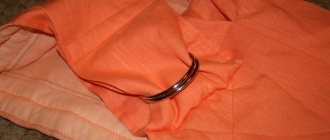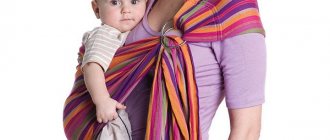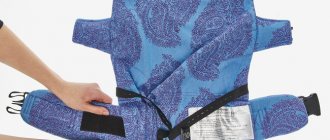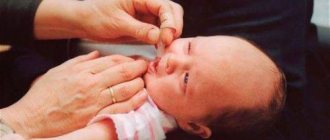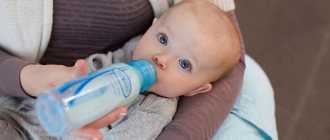A sling is one of those modern devices that, along with a washing machine and diapers, have made life much easier for today's mothers. However, young parents have a lot of questions about its use. If some are interested in how many months you can carry a child in a sling, then others are puzzled by the other side, until what age can you carry a child in a sling. One way or another, it’s definitely worth understanding the intricacies of using this device.
For baby:
- Movement, warmth, the sound of the mother's voice, cozy tightness, easily accessible food - everything is the same as it was in the womb. This creates a feeling of absolute security, allows the baby to be in a calm mood and, without wasting time on crying or self-soothing, get acquainted with the world around him.
- At first, newborns tend to maintain their usual position with their legs tucked in and arms bent, so they feel uncomfortable on a completely flat surface. The movements of an adult who holds the baby in his arms help the baby relax and straighten up.
- In the sling, the baby lies the same way as in your arms. The sling follows the natural contour of the child's back, and the spine does not experience any stress.
- The rhythm of walking, heartbeat, and breathing of an adult contribute to better regulation of the child’s still unbalanced rhythms.
- Children have an innate need to be close to adults. If your baby spends most of his time lying horizontally in his crib and is only picked up to feed or soothe him, he may begin to suffer from colic, thumb sucking, and movements that will be jerky and uncoordinated. The child lulls himself to sleep by making monotonous rhythmic movements, for example, rocking from side to side. The breathing of such a baby is uneven, and his sleep is restless.
- During the day, the child constantly feels the movements of an adult, hears voices and many other sounds, since no one artificially creates silence around the sleeping baby. And at night it is quiet, the baby lies on the bed and hears the measured mother’s breathing. Therefore, children who are carried a lot in their arms during the day and put to sleep next to them at night do not confuse day with night. Close contact between mother and child contributes to the rapid development of circadian biorhythms and the production of hormones responsible for sleep at night and wakefulness during the day.
- Unexpected sounds can frighten a child if he is alone. In his mother’s arms, the baby, even frightened by sharp unexpected sounds, calms down when he sees his mother’s calm, smiling face.
- Constant tactile stimulation contributes to the rapid adaptation of the newborn and its better development.
- While being held, the baby takes part in the lives of adults and learns to interact with the people and objects around him.
- Babies who are carried in their arms do not suffer from diaper dermatitis, because, firstly, they are informed when they need to go to the toilet, and secondly, already wet diapers are changed quickly enough.
- In an upright position for children who are not yet able to sit independently (4-5 months), the weight is evenly distributed between the child’s legs and hips. Thus, the still soft developing ligaments do not suffer, as in “kangaroo”, where the entire load falls on the perineum. In addition, the vertical position in the sling prevents the development of hip dislocation, since it is physiologically natural for babies.
- Children who are carried in a sling for a long time during the day have good muscle tone, begin to sit and crawl easier and faster, and maintain good balance while walking. This is due to the fact that he spends most of his life not in a stationary crib, but constantly adapting to the movements of an adult, thereby training his vestibular apparatus.
- Babies whose need for closeness to an adult was satisfied in early childhood are less likely to ask to be held when they grow up. They feel more confident knowing that there is a safe haven in mom/dad's arms, and enjoy exploring the world around them.
- Since the baby is almost on the same level with the faces of adults and passively takes part in conversations, he masters a very important social skill - the ability to listen. Such a child does not require an adult to entertain him every minute, because you won’t get bored in your mother’s arms.
- The child’s emotional sphere develops faster and more harmoniously, since the baby constantly sees the parent’s emotions and sympathizes with them.
- The sling allows you to carry your baby in more than 7 different positions, suitable for different ages.
Is it harmful to carry a newborn in a sling?
If the mother does not have helpers - grandmothers or older children, she has to leave the baby alone, using strollers is also inconvenient - to get to the store, for example, and here a sling comes to the rescue - you can secure the child in a sling and do some household chores, and if you need to go out outside - a sling is much more convenient than a bulky stroller.
Is a sling harmful for a child, because the skeleton of a recently born baby continues to form after birth: the bone tissue is soft, the muscles are weak. In the first months, the baby cannot hold his head up on his own, so it is necessary to ensure an anatomically correct and reliable position of the body - this is precisely why slings are valuable. They allow you to fix the child in a physiological position - with legs widely apart.
Constantly feeling his mother, the baby feels protected and is less capricious. A sling is a very useful invention, and if you adhere to the rules of wearing a sling and fix the child in the correct positions, it will not be more harmful than a mother’s hands.
For mom/dad:
- A wide strip of fabric running diagonally across the back and a comfortable ergonomic shoulder strap help distribute the child’s weight between the adult’s shoulder, back and thigh. This design allows you to carry a child weighing up to 16 kg and feel comfortable.
- Many positions and the ease of alternating them allow you to carry your baby for a longer time.
- The sling helps to establish and facilitate breastfeeding. The first months are usually the most difficult for new mothers. The child constantly “hangs on his chest”, prefers to sleep in his arms, but as soon as he is put in the crib, he immediately wakes up. Many cannot withstand such stress and switch babies to regular feedings or give the baby a pacifier instead of a breast, which leads to a lack of milk. The sling is great for promoting successful breastfeeding by helping to solve these problems. A child who is constantly at the breast, smelling it, ensures the flow of milk with frequent sucking. The baby does not need to cry to call his mother for help; the saved energy goes towards growth and development. Mom can, without hesitation, feed on the go anywhere and at any time, without interrupting her activities - this helps get rid of the feeling that the baby is constantly interfering and disrupting plans, and from the desire to run away from him. Feeding on demand is the key to successful breastfeeding and does not require significant sacrifice if the baby is always with the mother.
- Postpartum depression is less common in women who carry their babies using a sling. This may be due to the production of hormones and reducing the child's anxiety. With frequent stimulation, the mother's hormone levels are constantly high, and do not fluctuate up and down, as happens if the mother is separated from the child most of the day. From a biological point of view, maternal hormones have a calming effect, which allows the mother to avoid depression. In addition, the risk of depression is also reduced because such a child screams less and the mother feels more confident.
Thesis two: the sling is harmful to the child’s musculoskeletal system
Confirmation
A similar hazard can occur if the transfer device is not used correctly. Some irresponsible mothers carry their children with their legs pressed together and pulled to the side. Another incorrect position is that children’s legs are strongly bent at the knees.
Refutation
Although a sling can be used from birth, a small child should only be carried in an age-appropriate position. For example, up to four months, it is better to keep babies in a horizontal position. In some models, you can also wear it vertically without fear of harming the musculoskeletal system. Spread your baby's legs in different directions and secure them. The wrapped fabric will press the baby tightly against you and take the load off the spine. It turns out that this pose can help prevent hip dysplasia.
Which product to choose: detailed recommendations
Choosing a baby carrier is not as simple as it might seem. A young mother should pay attention not only to appearance, but also to other characteristics:
- Purpose of acquisition.
Slings for shopping and constant movement are very different. For the first one, a pocket or a sling with rings is suitable. For constant wearing, a sling scarf (for newborns), a fast sling or an ergo-backpack (for children from 3 months) are more suitable.
- Weight and age of the baby.
- Possibility of breastfeeding (if planned).
Such a sling should have a horizontal position and be able to cover the baby's face.
- Quality of materials (one of the main criteria).
As mentioned above, it is better to choose natural fabrics (linen, cotton, cashmere), metal rings and thick plastic.
- Price.
A quality product cannot be cheap.
There are no universal slings; pediatricians advise purchasing several at once for different purposes. For winter and late autumn, insulated products are used that will additionally protect the baby from bad weather; you can buy a sling jacket with an insert. For hygienic reasons, it is more advisable to use separate devices at home and outdoors.
Advice from pediatricians and babywearing consultants on the relationship between the type of sling and the age of the child:
- for newborns and babies up to six months, a ring sling or scarf is suitable;
- from 6 to 12 months you can use all the described sling models;
- After a year, you should give up ring slings; all others (if they do not cause discomfort to the mother can be used for up to 3 years or longer).
Signs of a low-quality sling:
- hard or very soft back;
- impossibility of precise adjustment of the child’s position.
Several manufacturers of products for carrying children have proven themselves:
- "Miracle child";
- Manduka;
- AMAMA;
- Boba;
- Velina;
- Elleville Zara;
- "Echidna";
Description and general characteristics
A sling is a piece of fabric that allows you to secure a baby to the mother’s body and carry it to different distances. The devices are made from natural fabrics and come in several varieties designed for different purposes.
Slings can be used from birth until the child is 2-3 years old. Thanks to the usual cut of fabric, the baby can take a lying or sitting position on the woman’s chest, side and even back.
Despite the fact that mothers with slings only recently stopped causing surprise among passers-by, the history of the device is quite long. An image of a woman wearing a sling-like object was found in the tomb of the Egyptian priest Montuemhat, who lived a millennium BC. Women with a child in a sling can be seen in the paintings of many famous painters until the 19th century.
Since that time, there has been a tendency to “keep the child away from the mother” so as not to spoil him, the sling was replaced by strollers and forgotten by modern European society. Residents of Asian and African countries continued to carry their children this way.
A new round of popularity for slings began in the last third of the last century, when it was proven that Asian and African children are ahead of their peers from developed countries in physical and psycho-emotional development due to closeness with their mother. In Russia and the CIS countries, slings began to be used less than 10 years ago.
Since then, several types of fabric devices for carrying children have appeared, and the number of slingomas is increasing every year, even in conservative countries.
conclusions
Among ordinary people who are not familiar with the sling, you can hear the opinion that it is dangerous for the baby and there is no need to use it. This theory only occurs if the mother violates the rules of babywearing. The benefits of the device have been proven and scientifically substantiated, as already mentioned above.
One of the most popular models for carrying children is an ergo-backpack; it is easy to use and has a very attractive appearance. Many people use it for newborns, placing fabric under the back to reduce the size of the backpack if it is large. Such actions can lead to poor posture; you can carry your baby in a backpack only when he learns to sit independently, from about 6 months.
Experts say that the safest and most ergonomic is a sling scarf, and although many are intimidated by the complexity of use, it disappears after several workouts.
Slings are gaining popularity among more parents. This simple device can make life significantly easier and provide additional closeness to the baby and mother without effort. In order not to be mistaken in the variety of slings available, you should consult with a specialist before purchasing.
Advantages
Slings have opponents and supporters. The first believe that the device does not ensure the anatomically correct position of the child and can harm the baby. Most pediatricians are still inclined to believe that the sling promotes the normal development of the baby’s physical and mental development, normalizes digestion and reduces pain during intestinal colic.
Advantages of using a sling:
- the ability to perform almost any job without parting with the baby;
- feeding the baby on demand anywhere (especially important for weak and premature babies);
- freedom of movement for women, the opportunity to remain mobile on the street, in transport and public places;
- no need to lift a heavy stroller;
- constant contact between the child and the mother, which has a beneficial effect on the child’s behavior. Babies in a sling are much less capricious; they calm down when they hear their mother’s heart and see her face all the time;
- ease of use and care;
- an increase in the amount of breast milk and the duration of the lactation period due to increased production of oxytocin in the woman’s body;
- children, moving with their mother, explore the world much more actively;
- saving time: when using a sling, there is no need to rock the baby, he will quickly fall asleep and sleep soundly even in a public place.
As practice shows, baby sling mothers quickly return to their former shape, because using a fabric carrier for several hours a day keeps muscles toned and shapes posture. And doing ordinary things with a few extra pounds can replace the gym.
Slings have some disadvantages that depend on the model.
Dr. Komarovsky talks about the need and correct use of slings.
